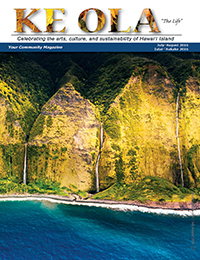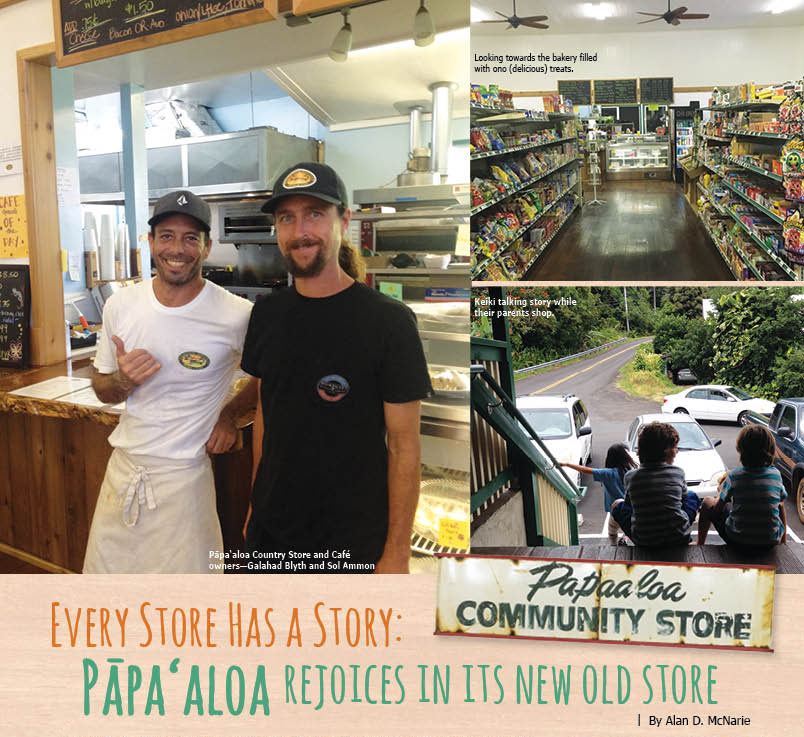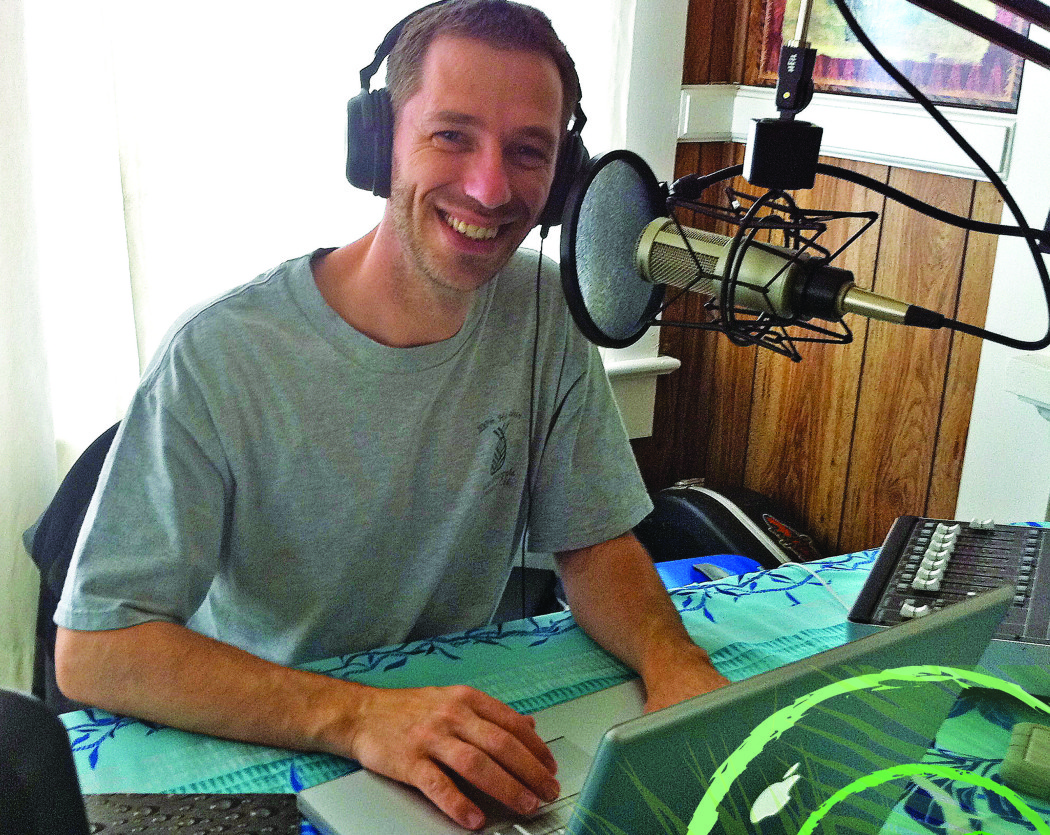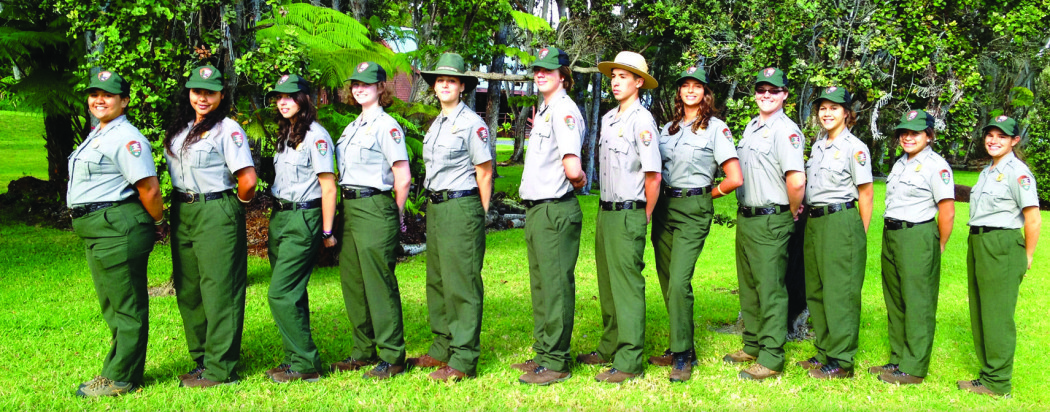
Pāpa‘aloa Rejoices in its New Old Store
By Alan D. McNarie
At the back of the Pāpa‘aloa Country Store and Café, near the new monkeypod counter where customers pick up orders from the renovated kitchen, are the faded inked outlines of shoe soles, each one slightly smaller than the previous. They were used, explains Avira Cacabelos, by generations of local children to figure out the right size of “slippahs” when they picked a new pair of sandals off the nearby rack.
Alvira should know. She used those outlines to choose slippahs herself, when she was a child. “All my life I came here,” she says, “and then I came to work here. I used to be a cashier and a kitchen helper. We used to do catering on the weekends for parties. I didn’t work for 10 years, after the store closed.” She says she’s “blessed and fortunate that I got to come back here and work again.”
Now a new generation of keiki on the North Hilo-Hāmākua Coast can once again buy their slippahs at the venerable store, thanks to three young kama‘āina entrepreneurs. Sol and Kristina Ammon and their brother-in-law, Galahad Blyth, reopened the store about a year ago.
“My in-laws bought this building about 10 years ago. They renovated it, but couldn’t find a buyer or renter,” says Sol. “They were kind of at their wits’ end with it, so we decided to give them some ideas.”
As it turned out, the best idea was to make the building exactly what it was for generations: a village general store and café. There have been a few changes—the shelf with the sandals is now at the front of the store, for instance, far from those outlines on the floor. The kitchen’s been completely renovated, and there are plans for a new dining room. Yet the ceiling fans still turn lazily over counters holding nearly everything a small community might need, from pet food to raincoats to children’s toys.

“It’s always been a general store, from the beginning of the plantation era,” says Sol. “No one knows how old the building is. It was already standing when the county began keeping records, but it probably dates back to before the turn of the 20th Century. We found receipts in the basement dating back from 1901, and a bunch from 1912.”
In the late 1800s and throughout most of the 1900s, Pāpa‘aloa was the hub of a vast network of cane fields, plantation “camps” (worker communities), railroads, trestles, and flumes that channeled sugarcane to Laupāhoehoe Sugar Company’s largest—and from the 1890s on, its only—sugar mill. It was a network that directly employed more than 900 workers in its heyday, and gave indirect employment to hundreds more, from bank clerks to movie projectionists (in the 1880s, Pāpa‘aloa even had its own movie theater). For much of the 20th Century, there was still a garage and a bank—though the general store did some of its own banking as well, giving customers credit until the sugar mill’s payday.
If the mill was the heart of the coast’s economy, the general store was its soul, its social hub. People even came here to shop for Christmas presents; Alvira still has a treasured little pendant from the store that that appeared under the tree for her one Christmas. Residents picked up their mail at the village’s post office, which occupied one corner of the store. They shared gossip and loco mocos at the café. Sumio and Asako Shitabata, the last store owners during the plantation era, had a reputation as gracious hosts.
“Sumio just passed away [March 4, 2016]. He used to sit on the porch every day and greet the customers, and they also used to do a lot of catering. Asako was famous for her cooking,” remembers Alvira.
The social and economic community that was Pāpa‘aloa collapsed with the rest of the sugar industry in Hawai‘i during the 1980s and 1990s. The mill here closed in 1989. The Shitabatas finally closed their store about 17 years later. Only the post office stayed open in what appeared to be a dying plantation town—until Galahad, Sol and Kristina stepped in.
In the meantime, the Hāmākua Coast itself has changed. “King Cane” has yielded his throne to a triumvirate of diversified farming, real estate, and bed-and-breakfasts. A sea of sugarcane has been replaced by a patchwork of diversified farms: sweet potatoes, lychee, ginger, dairy, and beef cows. Luxury homes are sprouting among the old planation camps.
The local economy, says Sol, is “growing quite extensively. There’s the largest charter school in the state right up the road. [There’s] a lot of influx of tourism and people from other islands moving into this area.”
The store’s café reflects that new Hāmākua Coast. “Back then, it was just local food—Japanese, Hawaiian, Filipino food,” recalls Alvira. The menu still holds reasonably priced local favorites: teri beef, lau lau, chicken katsu, mac salad, and of course, loco moco—and alongside them are healthier, more upscale dishes: Hamakua Mushroom Stir Fry, Veggie Avocado Sandwich and “Terrific Tri-tip Sandwich: Big Island beef, marinated and sliced thin on a house bun with Aunty Donna’s Smokin’ Barbecue sauce.” Alvira cooks under the supervision of head chef Kekoa Antonio, formerly of Kaleo’s and the Coconut Grill, and customers, many evenings, can dine to the music of local musicians.
At 7pm, after the store closes, baker Claire Gehweiler, formerly of e-claire’s Bakery in Hilo, takes over the new kitchen to produce tarts and cheesecakes, bear claws and mac nut sticky buns, cream puffs and, of course, eclairs. She also does custom cakes on order.
The café’s new cuisine appears to be working, both with locals and visitors. The Margherita pizza seems particularly popular; one New York traveler and pizza connoisseur said it made her family “feel like home.” Others have singled out the home-made ice cream sandwiches, the kalua pork plate lunch, the “awesome” burgers, the purple sweet potato cheesecake, and Claire’s pastries for special praise.
Like the sugar mill before it, the little country store is building its own network, becoming the hub of its own community. That effort has included connecting with local food producers.
“We get a lot of farmers dropping off their produce, fishermen bring in their fish, plus local eggs,” says Galahad.
Buying local helps the store in multiple ways. First, it endears the store to the producers, especially the new breed of small farmers who are proliferating along the coast. Those folks, in turn, may also buy their other groceries and dog food, propane and slippahs at the store. Buying local produce also gives the store and restaurant fresh, healthy food to sell, which appeals to both the old-time residents and newcomers.
“That’s really the trend in the grocery in general: the movement toward health food and just healthier food in general,” believes Sol. “People want to know where their food is coming from more and more. The idea of eating local—all your food coming from within a hundred miles—is becoming more and more important to people.”
The store is taking advantage of its location to appeal to tourists and commuters who drive the Belt Road from East Hawai‘i to Kona and Kohala every day. Customers also come from the small B&Bs and vacation rentals that are cropping up along the coast.
Most importantly, though, the store is connecting with the community itself—by being the general store, and by providing “a community gathering place,” as Sol puts it.
In addition to selling groceries and food, Sol, Kristina, and Galahad are hosting special events such as movie nights. The store hosts small meetings with everyone from local teachers to the “Out to Lunch Bunch,” a group of local women over 50 who get together there every other Thursday.
It’s 2pm on a typical afternoon and the store is bustling. A little girl and her brother are sitting at the keiki area’s child-sized table, playing foosball and munching pizza while their parents shop. A young bearded man peruses the community bookshelf, where people can trade used books for other books or just buy a copy for a small price. Four senior citizens sit, sipping bottled water and nibbling sandwiches. A young couple, with a toddler slung from the mom’s shoulders, are paying for cans of iced tea. A woman in a Panama hat orders a sandwich at the café counter while her 12-year-old is already munching on one of the store’s homemade ice cream sandwiches. A woman in rubber boots and camouflage overalls—except the “camouflage” contains large splashes of pink—brings in two large plastic containers of rattlesnake heliconia and leaves the flowers at the counter. Several people stand on the lānai, exchanging local news as they queue up at the post office window. A whole, diverse community is happily mixing and sharing.
“We have an overwhelming outpouring of community support,” beams Sol. “People are so thankful that we’re here, and we’re very thankful for that.” ❖
Photos courtesy Pāpa‘aloa Country Store
Contact Pāpa‘aloa Country Store and Café: 808.339.7614
Contact writer Alan D. McNarie



